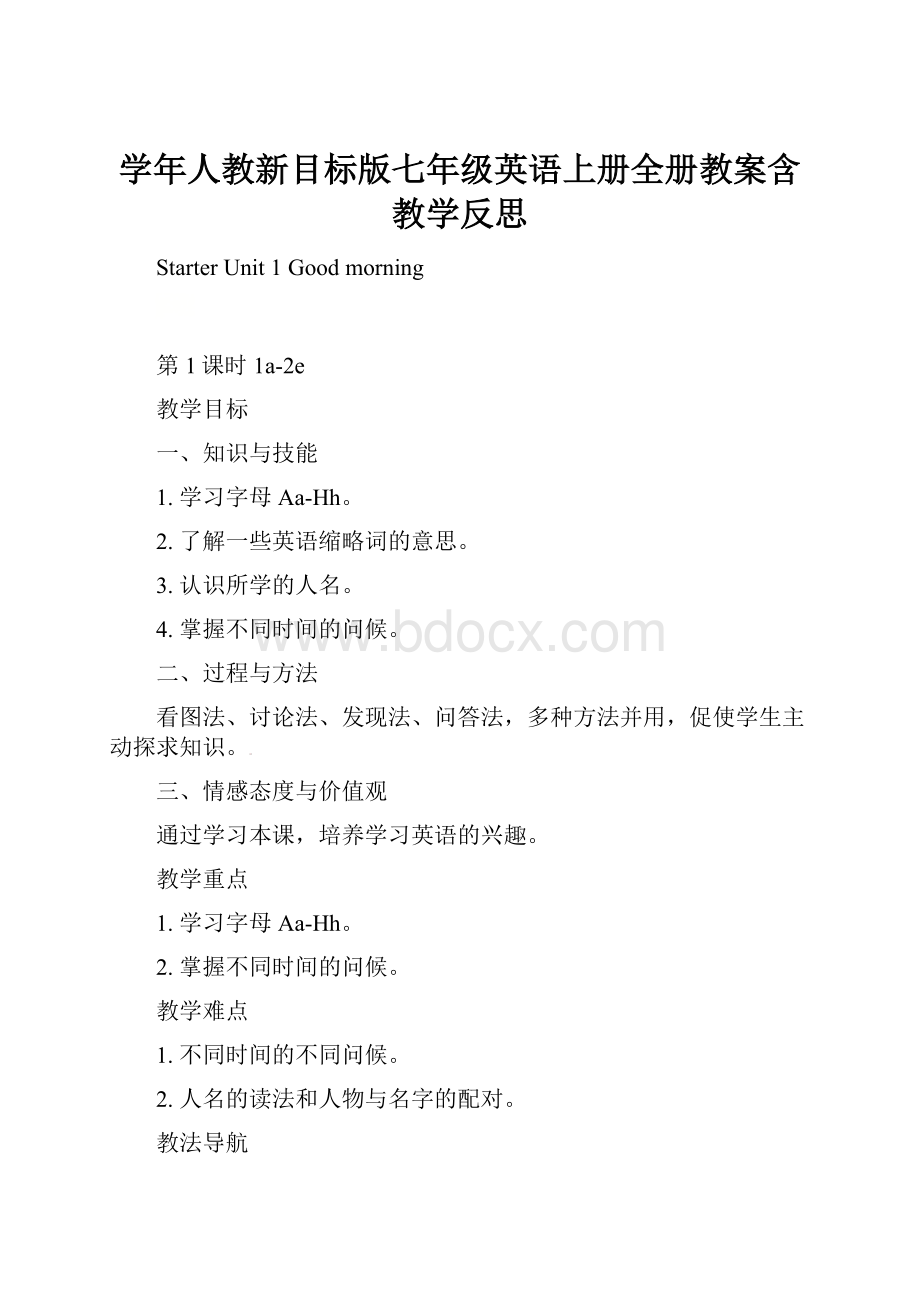学年人教新目标版七年级英语上册全册教案含教学反思.docx
《学年人教新目标版七年级英语上册全册教案含教学反思.docx》由会员分享,可在线阅读,更多相关《学年人教新目标版七年级英语上册全册教案含教学反思.docx(178页珍藏版)》请在冰豆网上搜索。

学年人教新目标版七年级英语上册全册教案含教学反思
StarterUnit1Goodmorning
第1课时1a-2e
教学目标
一、知识与技能
1.学习字母Aa-Hh。
2.了解一些英语缩略词的意思。
3.认识所学的人名。
4.掌握不同时间的问候。
二、过程与方法
看图法、讨论法、发现法、问答法,多种方法并用,促使学生主动探求知识。
三、情感态度与价值观
通过学习本课,培养学习英语的兴趣。
教学重点
1.学习字母Aa-Hh。
2.掌握不同时间的问候。
教学难点
1.不同时间的不同问候。
2.人名的读法和人物与名字的配对。
教法导航
通过看图,看视频,听录音,问答、讨论等方法学习字母和问候语。
学法导航
通过看、听、说等各种途径,以小组合作的形式,主动探求知识,锻炼自主学习能力。
教学准备
多媒体,字母卡片,英文歌曲磁带。
教学过程
Step1:
Greetings
Greetthestudentsasusual.
Step2:
Leadin
Asong
Listentoasong“Goodmorning!
”.Thenthestudentslearntosingthissong.
Step3:
Introduction
Comeintotheclassroomandgreetthe
classwithasmileandsayGoodmorning!
Now
introducethewords“teacher”and“class”byusinggestures.Repeatthisseveraltimesandhavetheclassrepeatafteryou.Thestudentscananswerasawholegroup,asrowsandasindividuals.Repeat“Iamyour
teacherandyouaretheclass”severaltimes.YoumaywanttoleavetheclassagaintointroducetheusualGoodmorningroutine.SayGoodmorning,class.Helpthestudentsrespondwith“Goodmorning.
”.Pointtoyourselfandsay:
I’mMiss/Mr....Havethemrepeat.ExplainthetermsMissandMr.inChinese.
Repeatthisafewtimeswithrowsandindividuals.
Miss,Mr....(Thestudentsrepeat.)
Morning,Miss/Mr.…(Thestudentsrepeat.)
Goodmorning,Miss/Mr....(Thestudentsrepeat.)
Step4:
Practice
Say:
Standup,please!
withgestures.(Thestudentsstandup.)
Leavetheclassroom,returnandsay:
Goodmorning,class!
Helpthestudentsrespondwith“Goodmorning,Miss/Mr....”Say:
Sitdown,please.Nowlet’sstartthelesson.
Step5:
Listenandrepeat
SayOpenyourbooks,turntopageS1.Thereare8studentsinthepicture.(按图片上的人物数)One,two,three,four,five,six,seven,eight.Theirnamesare
:
Grace,Bob,Dale,Helen,Eric,Frank,CindyandAlice.(可以通过大屏幕展示第S1页上的彩图,然后再展示单张图片,并分别与名字相对应。
)Thestudentsrepeataftertheteacheronebyoneuntiltheyknoweveryoneinthepicture.
Playthetape,thestudentslistenandrepeat.(利用时间与图表来补充:
Goodafternoon!
Goodevening!
解释运用这两个问候语时的情景。
)
Step6:
Pairwork
Getthestudentspracticetheconversationinthepicture.(Betweenboysandgirlsordeskmates.Everystudentcanchooseoneof
thenamesinthepicture.).
——Goodmorning,Helen!
——Goodmorning,Bob!
——Goodafternoon,Eric!
——Goodafterno
on,Grace!
——Goodevening,Helen!
——Goodevening,Dale!
——Hi,Alice!
——Hi,Cindy!
——Hello,Frank!
——Hello,Dale!
AskthestudentstotelltheclasstheirEnglishnames.IfanyofthemhavenoEnglishnames,pleasechooseoneafterclass.ThenpracticetheconversationagainwiththeirownEnglishnames.
Step7:
Explanation
1.Goodmorning/afternoon/evening!
适用于比较正式客气的场合,双方都应说Goodmorning/afternoon/evening!
例如:
A:
Goodmorning,MissZhao.早晨好,赵老师。
B:
Goodmorning,Mr.Wang.早晨好,王校长。
2.Morning.适用于比较熟悉的朋友之间或比较繁忙的情况下。
3.Hello.是最广泛、最简单的打招呼语,显得亲切自然。
例如:
A:
Hello,Kate.你好,凯
特。
B:
Hero,LiLei.你好,李雷。
4.Hi.在现代英语中,hi比hello用得更多,显得更随和。
例如:
A:
Hi,HanMeimei.你好,韩梅梅。
B:
Hi,Lucy.你好,露西。
Step8:
Listen,repeatandwrite
Getthestudentstolistentothetape2aandthenrepeatafterthetapeonebyone.PayattentiontothepronunciationofthelettersCc,FfandHh.
Havethestudents
watchtheteacherwritingthelettersontheblackboard,thenaskthemtofollowtheteacherandwritedowntheselettersontheirexercisebooks.Letthestude
ntskno
wthedifferencesbetweenthebiglettersandthesmallletters.
Step9:
Practice
Workon2cLookandcopy.
Workon2dWritethemissingbigletteronsmallletterforeachpair.
Step10:
Listening
Workon2bListenandnumberthelettersyouhear.
Step11:
Game
Showthestudentscardswithlettersonthemandgetthestudentstosaythem.Eachcard,eachletter.Thengetthestudentstopractiseingroups.
Step12:
Lookandtalk
Showthepicturesandgetthestudentstoguesswhatthelettersmean.
The
ntheteachershowsmorespecialletters.
Finallythestuden
tstrytothinkofotherspecial
letters.
(补充生活中常见的缩略词,如:
VCD、DVD、NBA等,引起学生的兴趣和注意,激发他们去观察生活,使知识的学习为生活服务。
)
Step13:
Homework
1.Practisegreetingpeople.
2.PractisereadingthenamesofthestudentsonPage1.
3.ChooseanEnglishnameforyourself.
4.Copythelettersandtheconversation.
5.FindmorespecialletterslikeNBAandtheirmeanings.
(名字可以从书后的生词表中挑选,第二天上报给老师,每个学生现在只需记住自己的名字,挑出后不会读课后问老师。
)
课堂作业
一、写出下列字母的大(小)写
1.A_________2.b_________3.E_________4.g_________
5.h_________6.D_________7.C_________8.f_________
二、翻译
早上好!
___________________________________
参考答案:
一、1.a2.B3.e4.G5.H6.d7.c8.F
二、Goodmorning!
教学反思
虽然学生小学时都学过英语,但只注重说,对于写要求不严格。
所以,从初一开始就要规范学生的书写。
本节课学习了字母Aa-Hh的读法和写法。
在写法上,学生普遍不太注意笔顺,要向学生强调,让他们养成正确书写的好习惯。
StarterUnit1Goodmorning
第2课时3a-4d
教学目标
一、知识与技能
1.初步认识音素,并能辨
别简单的音素。
2.学会在正
确的时间进行正确的问好。
Goodmorning/afternoon/evening!
3.学会问候熟识的朋友和应答:
——Howareyou?
——I’mfine,thanks.Howareyou?
——I’mOK.
二、过程与方法
通过大量的例子让学生去体会问候语的意义,进而掌握他们的用法。
最后通过实践练习去巩固用法。
三、情感态度与价值观
学会有礼貌地打招呼,不管是熟人还是不熟悉的人。
教学重点
1.学会在正确的时间进行正确的问好。
Goodmorning/afternoon/evening!
2.学会问候熟识的朋友和应答:
——Howareyou?
——I’mfine,thanks.Howare
you?
——I’mOK.
教学难点
初步认识音素,并能辨别简单的音素。
教法导航
让学生自己总结规律,思考,讨论,最后得出结论。
创设英语语言氛围,使学生能较快地融入到英语语言学习的情景中来。
学法导航
自主学习,独立思考,
小组讨论,同桌合作,完成学习任务。
教学准备
1.用英语问好的小视频,课件。
2.复习上节课学习的打招呼的用语。
教学过程
Step
1:
Greetings
Greetthestudentsasusual.
Step2:
Revision
把下列大写字母按在字母表中的顺序排列然后写出小写字母。
DFGAHCB
Step3:
Game
Showthepicturesofa
day:
morning,afternoonandevening
.Andthenpractisethedialogue“Goodmorning/afternoon/evening!
”andgetthestudentstoguesstheirmeanings.
Step4:
Listening
Workon3aListenandnumberthepictures1-3.
Step5:
Groupwork
Firstdrawpictureswithclocksorsunstoshowthetimes.Andthengetthemtoaskandansweringroupslikethis:
Goodmor
ning/afternoon/evening!
Step6:
Video
Watchtheshortvideowith“Goodmorning,...!
”,“Howareyou?
”,“I’mfine,thanks.Howareyou?
”,“I’mOK.”
Asksomestudentstotranslatethemandthentrytoimitatetheshortdialogues.
Step7:
Groupwork
Workon4aWritethenamesofthechildrenonpageS1.Thenwritethenamesinalphabeticalorder.
Work
on3dThenchooseanEnglishnameforyourself.Thengreeteachother.
Step8:
Listenandrepeat
ListouttheletterA/ei/,/æ/ontheblackboardanden
couragethestudentstosayoutwhatother
wordsa1somakethesamepronunciation.Givethemsometips.Presenttheotherlettersthesameast
he1etterA,thenE/i:
/,/e/.
Step9:
Listening
Workon4bListenandrepeat.
Step10:
Pairwork
Workon4cWorkinpairsandreadthelettersandwordsincolumn1.Thentrytoreadthenewwordsincolumn2.
Step10:
Homework
Learntheletters,wordsandgreetingsinthisunitbyheart.
课堂作业
()1.早晨在校门口遇到同学时,应该怎么样打招呼?
A.Howareyou?
B.Goodmorning!
C.Goodevening!
()2.当别人向你问好时说:
Howareyou?
你应该怎么回应呢?
A.Fine,than
kyou.
B.Hello!
C.Howareyou?
()3.——Goodevening,Eric.——_________,
Cindy.
A.Goodmorning
B.Goodafternoon
C.Goodevening
()4.——Goodmorning!
——_________
A.Thankyou.
B.Goodmorning!
C.Hello!
()5.——Hello!
——_________
A.Hello!
B.Thankyou.
C.I’mfine.
参考答案:
1.B2.A3.C4.B5.A
教学反思
本课涉及到生活中的情境,学生感到很熟悉,学起来就快。
再用多种形式加以巩固,学习效果较好。
StarterUnit2What’sthisinEnglish
第1课时1a-2e
教学目标
一、知识与技能
1.掌握Ii-Rr英语字母的发音及书写。
2.Improvethelisteningskill.
3.
新单词:
what、is、map、cup、ruler、pen、orange、jacket、key。
二、过程与方法
采用目标和任务教学法,调动学生的积极性,引导他们积极参与课堂。
三、情感态度与价值观
提高认知能力。
教学重点
1.掌握Ii-Rr英语字母的发音及书写。
2.Improvethelisteningskill.
3.新单词:
what、is、map、cup、ruler、pen、orange、jacket、key。
教学难点
1.Improvethelisteningskill.
2.新单词:
what、is、map、cup、ruler、pen、orange、jacket、key。
教法导航
兴趣活动教学策略,充分调动学生的积极性。
学法导航
通过组内合作和组间比赛等活动,提高学生的合作能力和竞争能力,促使学生学会体验实践、参与合作与交流的学习方式。
教学准备
多媒体课件。
预习新单词:
听录音机,模仿跟读新单词和字母;准备与本课有关的学习用品实物。
教学过程
Step1:
Greetings
Greetthestudentsasusual.
Step2:
Warmingup
1.Goodmorning/afternoon/evening!
Howareyou?
I’mfine,thanks.
Howareyou?
I’mOK.
2.Singthealphabetsong
Step3:
Games
1.Theteachershowsaletterquicklyonthescreenandasks:
What’sthis?
Getthestudentstoanswerthequestionslikethis:
Ithinkit’sA/B.Thenshowthewholeofthelettertoletthestudentscheckwhetherthey’rerightorwrong.
2.GothroughthelettersAa-Hhquickly,payattentiontotheintonation.Thenplayagame:
Listenandpicktherightletter,thenarrangethelettersintherightorderandreadalo
ud.
Step4:
1a-1c
Workon1aLookforthesmalllettersinthepictureforthesebigletters.
Workon1bListenandrepeat
Askthestudentstofinishthetwotasks.
Workon1cMakeaconversation
inpairsaccordingtothepicturein
1a.
Havetwopairspresenttheirdialoueinfrontoftheclass.
Step5:
Pr
esentation
TeachthelettersIi-RrbyusingWhat’sthisinEnglish?
It’sIi/Jj/...
Step6:
2a-2e
1.Finish2a.
2.2bListentothetapeandwritethenumberofthelettersintheboxesaccordingtotheorderinwhichyouhearthem.Playtherecordingt
wiceandchecktheanswer.
3.Lookandcopytheletters
4.2dWritethesmallletters(orbigletters)forbig
letters(smallletters).Whilethestudentsaredoingthetasks,theteachergoesaroundtheclassroomtocheckwhattheyaredoing.
5.Askthestudentstotalkaboutthespecialletters.Afewminuteslater,theteachergetsthreestudentstosaythem
eaningsoftheseletters.
Step7:
Homework
CopythelettersfromAa-Rr.
MakelettercardsIi-Rrandcolourtheletters.
课堂作业
Lookand
copythelettersIi–
Rr.
教学反思
学习字母是相对容易的课,学生很容易失去兴趣,因此本节课的关键是调动学生的积极性,激发他们的学习兴趣比如第3步Games很符合学生的心理,效果不错。
StarterUnit2What’sthisinEnglish
第2课时3a-4